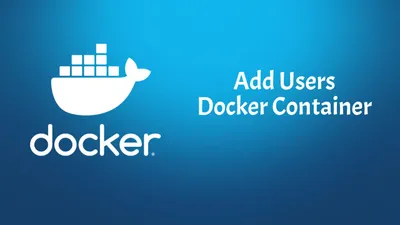How to Self-Host SearXNG — Privacy-Focused Metasearch Engine
Learn how to self-host SearXNG, a powerful privacy-focused metasearch engine that aggregates results from multiple search engines while keeping your searches private. Complete guide with Docker, Traefik, and Dokploy setup options.
In today’s digital landscape, privacy has become a precious commodity. Every search query you make is tracked, analyzed, and used to build detailed profiles about your interests and behaviors. Popular search engines like Google, Bing, and Yahoo collect vast amounts of personal data, raising concerns about digital privacy and autonomy.
This is where SearXNG emerges as a powerful solution—a self-hosted, privacy-focused metasearch engine that puts you back in control of your search experience. By aggregating results from multiple search engines while maintaining complete anonymity, SearXNG offers the best of both worlds: comprehensive search results without sacrificing your privacy.
What is SearXNG and How Can It Transform Your Search Experience?
SearXNG is a free, open-source metasearch engine that revolutionizes how you interact with search technology. Unlike traditional search engines that track and profile users, SearXNG acts as an intermediary that queries multiple search engines simultaneously while preserving your anonymity.
Key Benefits of SearXNG
- Complete Privacy Protection: No tracking, cookies, or user profiling
- Aggregated Results: Combines results from 230+ search engines for comprehensive coverage
- Customizable Experience: Choose which search engines to include and configure preferences
- Open Source Transparency: Fully auditable code with active community development
- Self-Hosted Control: Complete ownership of your search infrastructure
- Multi-Language Support: Available in numerous languages with localized results
How SearXNG Works
The magic of SearXNG lies in its metasearch architecture:
| Component | Function | Benefit |
|---|---|---|
| Query Distribution | Sends your search to multiple engines | Comprehensive results |
| Result Aggregation | Combines and deduplicates responses | Unified experience |
| Privacy Layer | Acts as intermediary proxy | Anonymous searching |
| Customization Engine | Filters based on preferences | Personalized results |
SearXNG is a fork of the original Searx project, enhanced with additional features, improved performance, and better maintenance. You can explore the project further at their official GitHub repository and documentation site.
For a comprehensive list of useful applications, check out our guide on Docker containers for home servers.
Prerequisites
Before embarking on your SearXNG self-hosting journey, ensure you have the following infrastructure components in place:
Hardware Requirements
SearXNG is lightweight but performs best with adequate resources for handling multiple search engine queries simultaneously.
-
VPS or Dedicated Server: A reliable hosting platform where you can install SearXNG. We recommend Hetzner for excellent performance and pricing. For optimal experience, consider:
- Minimum: 2 CPU cores, 2GB RAM, 20GB storage
- Recommended: 4+ CPU cores, 4GB+ RAM, 40GB+ storage
- Alternative: Mini PC as Home Server for local hosting
-
Reverse Proxy Setup (for HTTPS access):
- Option 1: Traefik with Docker configured - follow our guide: How to Use Traefik as A Reverse Proxy in Docker
- Option 2: Traefik with Let’s Encrypt wildcard certificates - see: Traefik FREE Let’s Encrypt Wildcard Certificate With CloudFlare Provider
-
Container Management: Docker and container orchestration tools:
- Docker Engine: Latest stable version
- Docker Compose: For multi-container orchestration
- Dockge (optional): Simplified Docker management - tutorial: Dockge - Portainer Alternative for Docker Management
-
Domain Name: A domain or subdomain pointing to your server (e.g.,
search.yourdomain.com)
Setup Option 1: Docker & Docker Compose (Standalone)
This method provides a straightforward installation using Docker containers without additional complexity. Perfect for users who want a simple, self-contained SearXNG instance.
Step 1: Create Project Directory
Begin by establishing a dedicated directory structure for your SearXNG installation:
mkdir -p ~/searxng && cd ~/searxngStep 2: Create Docker Compose Configuration
Create a comprehensive docker-compose.yml file that includes SearXNG with Redis caching for optimal performance:
version: '3.8'
services:
searxng:
image: "docker.io/searxng/searxng:latest"
container_name: "searxng"
volumes:
- "./config:/etc/searxng:rw"
ports:
- "8080:8080"
environment:
- PGID=1000
- PUID=1000
- SEARXNG_BASE_URL=http://localhost:8080
- SEARXNG_REDIS_URL=redis://redis:6379/0
- UWSGI_WORKERS=4
- UWSGI_THREADS=4
cap_drop:
- ALL
cap_add:
- CHOWN
- SETGID
- SETUID
depends_on:
redis:
condition: service_healthy
restart: unless-stopped
redis:
container_name: searxng-redis
image: docker.io/valkey/valkey:8-alpine
command: valkey-server --save 30 1 --loglevel warning
restart: unless-stopped
volumes:
- "redis-data:/data"
cap_drop:
- ALL
cap_add:
- SETGID
- SETUID
- DAC_OVERRIDE
- CHOWN
healthcheck:
test: ["CMD", "valkey-server", "--version"]
interval: 10s
timeout: 5s
retries: 3
start_period: 10s
volumes:
redis-data:Step 3: Initialize Configuration Directory
Create the necessary directory structure for SearXNG configuration files:
mkdir -p configStep 4: Launch SearXNG
Deploy your SearXNG instance using Docker Compose:
docker compose up -dStep 5: Access Your Search Engine
Once the containers are running, access SearXNG through your web browser:
- Local Access:
http://localhost:8080 - Network Access:
http://your-server-ip:8080
Installation Complete
Your SearXNG instance is now operational! You can begin searching immediately while enjoying complete privacy.
Setup Option 2: Traefik & Dockge Integration
This advanced setup integrates SearXNG with Traefik reverse proxy and Dockge container management, providing HTTPS encryption, automatic SSL certificates, and simplified management through a web interface.
Prerequisites for This Method
Ensure you have Traefik and Dockge properly configured by following our Traefik Wildcard Certificate guide.
Step 1: Prepare Traefik Network
Verify your Traefik network exists and create if necessary:
docker network create traefik-netStep 2: Enhanced Docker Compose with Traefik Labels
Create a production-ready docker-compose.yml with Traefik integration:
version: '3.8'
networks:
traefik-net:
external: true
services:
searxng:
image: "docker.io/searxng/searxng:latest"
container_name: "searxng"
volumes:
- "./config:/etc/searxng:rw"
environment:
- PGID=1000
- PUID=1000
- SEARXNG_BASE_URL=https://search.yourdomain.com
- SEARXNG_REDIS_URL=redis://redis:6379/0
- UWSGI_WORKERS=4
- UWSGI_THREADS=4
cap_drop:
- ALL
cap_add:
- CHOWN
- SETGID
- SETUID
networks:
- traefik-net
depends_on:
redis:
condition: service_healthy
restart: unless-stopped
labels:
- "traefik.enable=true"
- "traefik.http.routers.searxng.rule=Host(`search.yourdomain.com`)"
- "traefik.http.routers.searxng.entrypoints=https"
- "traefik.http.routers.searxng.tls=true"
- "traefik.http.routers.searxng.tls.certresolver=letsencrypt"
- "traefik.http.services.searxng.loadbalancer.server.port=8080"
redis:
container_name: searxng-redis
image: docker.io/valkey/valkey:8-alpine
command: valkey-server --save 30 1 --loglevel warning
restart: unless-stopped
networks:
- traefik-net
volumes:
- "redis-data:/data"
cap_drop:
- ALL
cap_add:
- SETGID
- SETUID
- DAC_OVERRIDE
- CHOWN
healthcheck:
test: ["CMD", "valkey-server", "--version"]
interval: 10s
timeout: 5s
retries: 3
start_period: 10s
volumes:
redis-data:Step 3: Deploy Through Dockge
- Access your Dockge interface (typically
https://dockge.yourdomain.com) - Create a new stack named “searxng”
- Paste the Docker Compose configuration
- Customize the domain name in the Traefik labels
- Deploy the stack
Step 4: Configure Domain DNS
Point your chosen subdomain to your server’s IP address:
| Record Type | Name | Value | TTL |
|---|---|---|---|
| A | search | your-server-ip | 300 |
DNS Propagation
Allow 5-15 minutes for DNS changes to propagate before accessing your SearXNG instance.
Setup Option 3: Dokploy Easy Deployment
Dokploy offers the most streamlined deployment experience with built-in templates and automated configuration. This method is ideal for users who prefer GUI-based management with minimal command-line interaction.
Step 1: Install Dokploy
If you haven’t already, set up Dokploy on your server following our comprehensive guide: Dokploy Installation Tutorial.
Step 2: Create SearXNG Application
- Access Dokploy Dashboard: Navigate to your Dokploy interface
- Create New Project: Click “New Project” and name it “searxng”
- Select Template: Choose “SearXNG” from the available templates or create a custom compose application
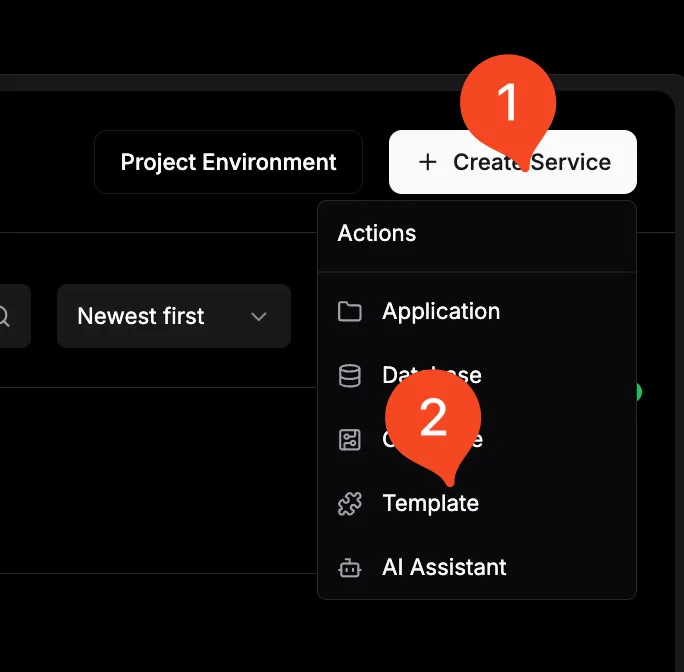
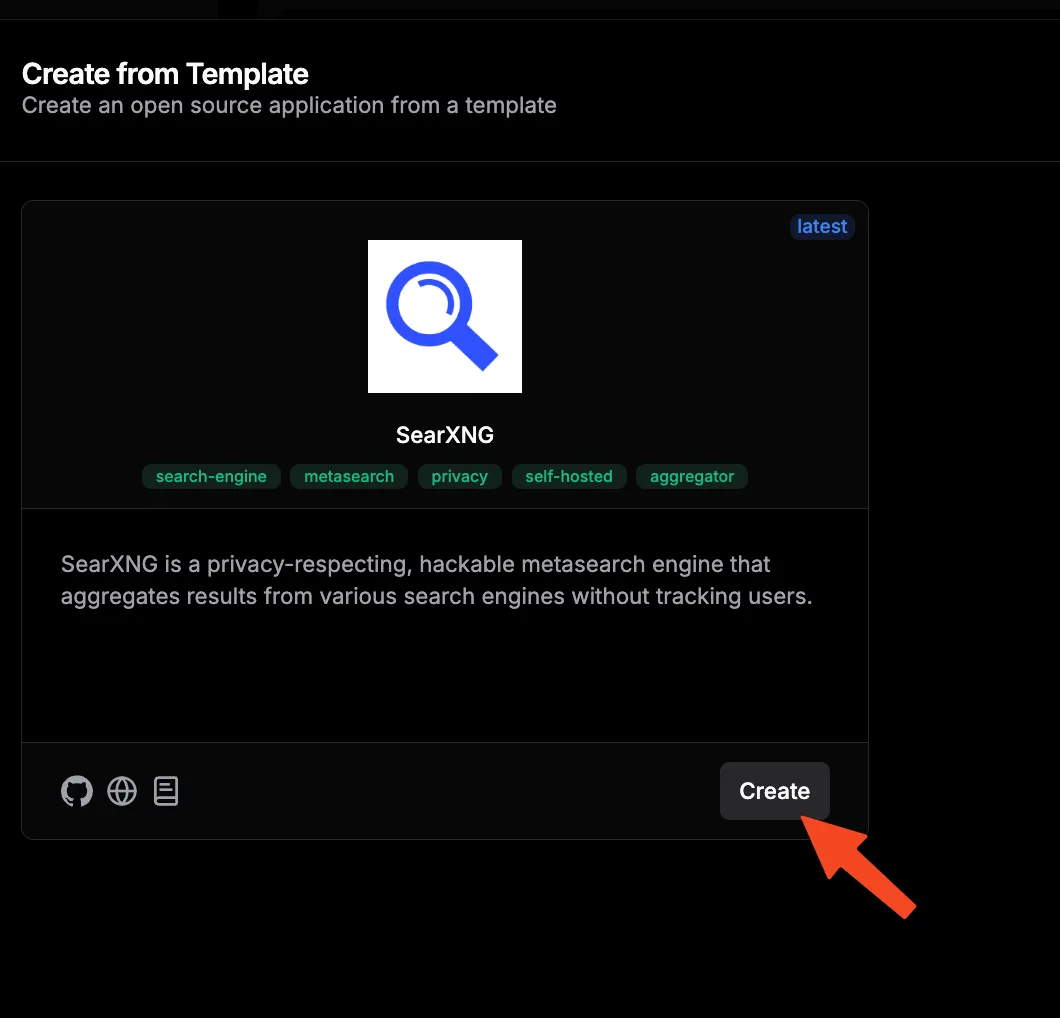
Step 3: Configure Environment Variables
Set up the following environment variables in Dokploy:
| Variable | Value | Description |
|---|---|---|
SEARXNG_BASE_URL | https://search.yourdomain.com | Your public URL |
UWSGI_WORKERS | 4 | Number of worker processes |
UWSGI_THREADS | 4 | Threads per worker |
PGID | 1000 | Group ID for file permissions |
PUID | 1000 | User ID for file permissions |
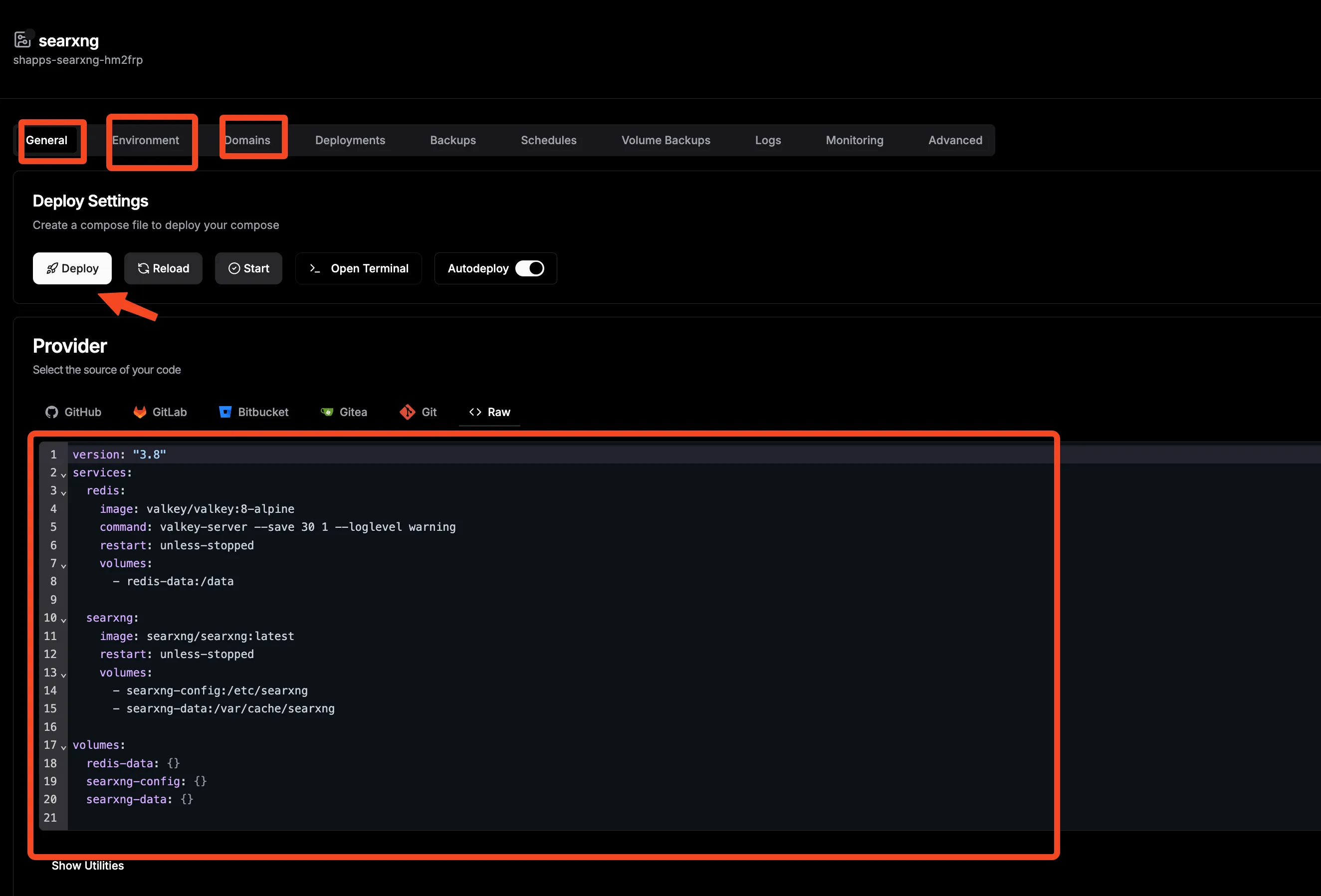
Step 4: Domain Configuration
- Navigate to the “Domains” section in your Dokploy project
- Add your domain:
search.yourdomain.com - Set Container Port (8080 for SearXNG)
- Enable SSL/TLS certificate generation in Certificate Provider
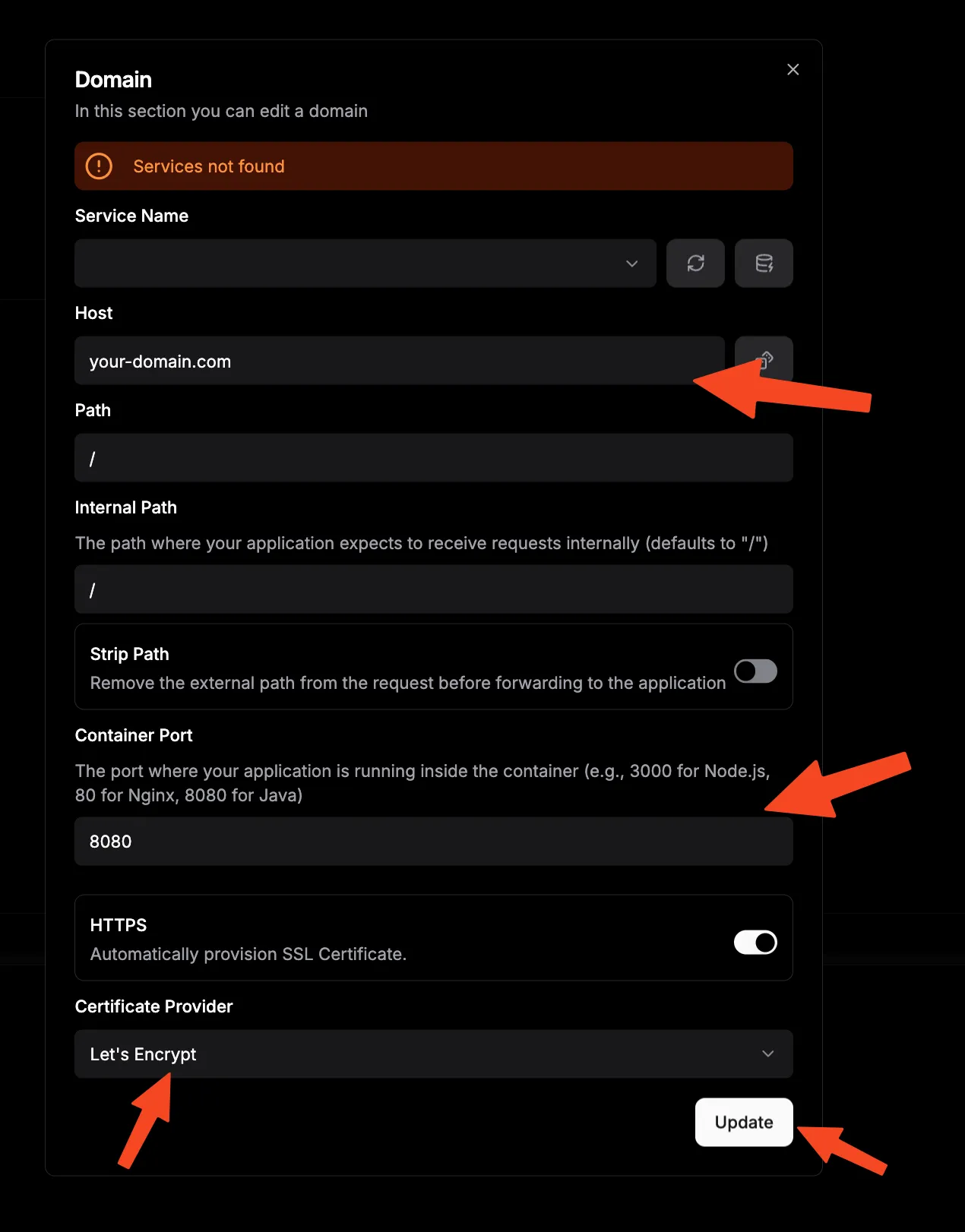
Step 5: Deploy Application
Click the “Deploy” button and monitor the deployment logs. Dokploy will automatically:
- Pull required Docker images
- Set up networking
- Generate SSL certificates
- Configure reverse proxy rules
Advanced Configuration and Customization
Once your SearXNG instance is operational, you can enhance its functionality through various configuration options.
Search Engine Selection
Navigate to Preferences → Engines to customize your search sources:
- General Search: Google, Bing, DuckDuckGo, Startpage, Yandex
- News Sources: BBC News, Reuters, Associated Press, Wikinews
- Academic: Google Scholar, Microsoft Academic, Semantic Scholar
- Media: YouTube, Vimeo, Flickr, Unsplash
- Shopping: Amazon, eBay, AliExpress
- Social: Reddit, Twitter, Stack Overflow

Privacy and Security Settings
Configure these essential privacy options:
| Setting | Recommended Value | Purpose |
|---|---|---|
| Safe Search | Moderate | Filter inappropriate content |
| Image Proxy | Enabled | Hide IP from image sources |
| Method | POST | Prevent query leaks in referrers |
| Autocomplete | Disabled | Avoid external service calls |
Performance Optimization
Fine-tune SearXNG performance based on your server specifications:
environment:
- UWSGI_WORKERS=8 # 2x CPU cores
- UWSGI_THREADS=4 # Adjust based on RAM
- SEARXNG_REDIS_URL=redis://redis:6379/0Custom Themes and Appearance
SearXNG supports multiple themes and customization options:
- Default Theme: Clean, modern interface
- Simple Theme: Minimal design with fast loading
- Oscar Theme: Feature-rich with advanced filters
- Pix-art Theme: Artistic, image-focused layout
Browser Integration
Setting SearXNG as Default Search Engine
For Firefox/LibreWolf:
- Navigate to
about:preferences#search - Click “Add Search Engine”
- Enter details:
- Name: SearXNG Privacy Search
- URL:
https://search.yourdomain.com/search?q=%s
- Set as default search engine
For Chrome/Chromium:
- Go to Settings → Search engine → Manage search engines
- Click “Add” next to “Other search engines”
- Fill in:
- Search engine: SearXNG
- Keyword: searxng
- URL:
https://search.yourdomain.com/search?q=%s
Browser Extension Benefits
Privacy Enhancement
Installing SearXNG as your default search enhances privacy by routing all searches through your self-hosted instance, eliminating tracking from commercial search engines.
Monitoring and Maintenance
Health Monitoring
Implement monitoring to ensure optimal SearXNG performance:
# Add to your docker-compose.yml
healthcheck:
test: ["CMD", "curl", "-f", "http://localhost:8080/search?q=test&format=json"]
interval: 30s
timeout: 10s
retries: 3
start_period: 40sRegular Maintenance Tasks
- Weekly: Review search engine performance and disable problematic sources
- Monthly: Update Docker images for security patches
- Quarterly: Analyze search patterns and optimize engine selection
- Annually: Review and update SSL certificates (if not automated)
Backup Strategies
Protect your SearXNG configuration with regular backups:
# Backup configuration
tar -czf searxng-backup-$(date +%Y%m%d).tar.gz config/
# Backup Redis data (optional)
docker exec searxng-redis redis-cli BGSAVETroubleshooting Common Issues
Search Results Not Appearing
Symptoms: Empty search results or specific engines not working
Solutions:
- Check engine status in preferences
- Verify network connectivity from container
- Review rate limiting settings
- Update engine configurations
Performance Issues
Symptoms: Slow search responses or timeouts
Solutions:
- Increase UWSGI workers and threads
- Optimize Redis memory allocation
- Disable problematic search engines
- Implement result caching
SSL Certificate Problems
Symptoms: HTTPS errors or certificate warnings
Solutions:
- Verify domain DNS configuration
- Check Traefik certificate generation logs
- Restart Traefik container
- Validate certificate resolver settings
Rate Limiting
Some search engines implement aggressive rate limiting. If you experience blocked requests, consider reducing the number of simultaneous engines or implementing request delays.
Security Best Practices
Network Security
- Firewall Configuration: Block unnecessary ports, allow only HTTP/HTTPS traffic
- VPN Access: Consider restricting access through VPN for enhanced privacy
- Regular Updates: Keep Docker images and host system updated
- Access Logs: Monitor and analyze access patterns for anomalies
Data Protection
| Component | Security Measure | Implementation |
|---|---|---|
| Search Queries | No logging | Default SearXNG behavior |
| User Sessions | No cookies | Disabled in preferences |
| IP Addresses | Proxy protection | Redis session storage |
| SSL/TLS | Strong encryption | Let’s Encrypt certificates |
Conclusion
Self-hosting SearXNG represents a significant step toward digital privacy and search independence. By implementing your own metasearch engine, you gain:
- Complete Privacy Control: No tracking, profiling, or data collection
- Search Result Diversity: Access to multiple search engines simultaneously
- Customization Freedom: Tailor the search experience to your preferences
- Infrastructure Ownership: Full control over your search infrastructure
- Cost Effectiveness: Minimal hosting costs for unlimited private searching
Whether you choose the straightforward Docker approach, the robust Traefik integration, or the streamlined Dokploy deployment, SearXNG provides a powerful foundation for private, efficient web searching. The investment in self-hosting pays dividends in privacy protection and search quality enhancement.
As digital privacy becomes increasingly important, tools like SearXNG demonstrate that you don’t need to compromise functionality for privacy. Take control of your search experience today and enjoy the freedom of truly private web searching.
Start Your SearXNG JourneyReady to explore more self-hosting opportunities? Check out our comprehensive guides on Docker container management, Traefik reverse proxy setup, and Dokploy platform deployment to expand your self-hosted infrastructure.

